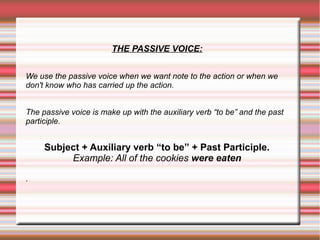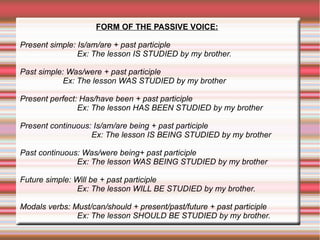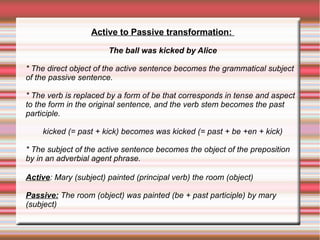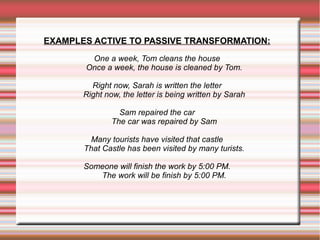The passive voice
- 1. THE PASSIVE VOICE: We use the passive voice when we want note to the action or when we don't know who has carried up the action. The passive voice is make up with the auxiliary verb âto beâ and the past participle. Subject + Auxiliary verb âto beâ + Past Participle. Example: All of the cookies were eaten .
- 2. FORM OF THE PASSIVE VOICE: Present simple: Is/am/are + past participle Ex: The lesson IS STUDIED by my brother. Past simple: Was/were + past participle Ex: The lesson WAS STUDIED by my brother Present perfect: Has/have been + past participle Ex: The lesson HAS BEEN STUDIED by my brother Present continuous: Is/am/are being + past participle Ex: The lesson IS BEING STUDIED by my brother Past continuous: Was/were being+ past participle Ex: The lesson WAS BEING STUDIED by my brother Future simple: Will be + past participle Ex: The lesson WILL BE STUDIED by my brother. Modals verbs: Must/can/should + present/past/future + past participle Ex: The lesson SHOULD BE STUDIED by my brother.
- 3. Active to Passive transformation: The ball was kicked by Alice * The direct object of the active sentence becomes the grammatical subject of the passive sentence. * The verb is replaced by a form of be that corresponds in tense and aspect to the form in the original sentence, and the verb stem becomes the past participle. kicked (= past + kick) becomes was kicked (= past + be +en + kick) * The subject of the active sentence becomes the object of the preposition by in an adverbial agent phrase. Active: Mary (subject) painted (principal verb) the room (object) Passive: The room (object) was painted (be + past participle) by mary (subject)
- 4. EXAMPLES ACTIVE TO PASSIVE TRANSFORMATION: One a week, Tom cleans the house Once a week, the house is cleaned by Tom. Right now, Sarah is written the letter Right now, the letter is being written by Sarah Sam repaired the car The car was repaired by Sam Many tourists have visited that castle That Castle has been visited by many turists. Someone will finish the work by 5:00 PM. The work will be finish by 5:00 PM.




